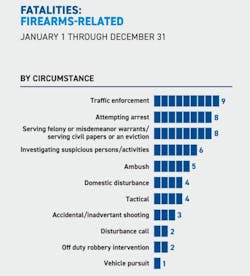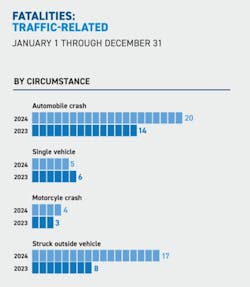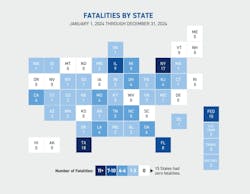2024 LODD Report: Police Officer Deaths Saw 25% Increase Last Year
The number of law enforcement professionals nationwide who died in the line of duty rose last year compared to 2023, along with the number of firearms-related and traffic-related fatalities. According to the 2024 End-of-Year Preliminary Law Enforcement Officers Fatalities Report released by the National Law Enforcement Officers Memorial Fund in January, there was a 25% increase in overall officer deaths compared to the previous year.
This article appeared in the January/February issue of OFFICER Magazine. Click Here to subscribe to OFFICER Magazine.
National Law Enforcement Officers Memorial Fund data shows that 147 federal, state, county, municipal, military, tribal and campus law enforcement officers died in the line of duty in 2024, compared to the 118 officers who died in the line of duty in 2023. The leading cause of lineof-duty deaths continued to be gunfire, while the largest increase over 2023 was from traffic-related incidents.
OFFICER Magazine recently spoke to Rosa Guixens, Executive Director of the National Law Enforcement Officers Memorial Fund and former chief of the Riverdale Park Police Department in Maryland, about what law enforcement agencies can take away from the report and what can be done to keep officers safer while on patrol.
Key takeaways
Guixens says that the biggest takeaway from the annual report was the overall increase in LODDs, but that the rise in both firearms-related fatalities and traffic-related fatalities also was alarming. “It’s still incredibly dangerous out on the street. There are still a lot of police officers are under attack.”
According to Guixens, law enforcement agencies across the country can take something away from the report. “I think we’re all working toward the same goal, we're all doing the same job,” she says. “Whether you're working in some little town or New York City, we're all doing the same job. We're working under different circumstances and in different environments, but we've all got the same purpose, and that is to enforce laws and keep people safe.”
She also spoke about the importance of training when it comes to addressing some of the key trends highlighted in the report. “Training is always huge," she says. “Officers have to rely on their training and revert to their training when it comes to these situations, whether you’re on the scene of an ongoing crash or whatever the case may be. Training is what keeps you alive.”
While funding is scarce—especially for smaller departments—local, state and federal grants can help fill some of those gaps to help pay for training and resources. “Take advantage of the grant opportunities that are out there,” she says. “It's tough because grants are difficult to write, but they're out there. If you start applying for some of these grants—especially as a smaller agency—and you can prove a need, they're going to send money your way.”
Firearms-related fatalities
Firearms-related fatalities claimed the lives of 52 law enforcement officers in 2024, which represents an 13% increase from the 46 officers killed by gunfire in 2023, and was the leading cause of death.
Of the 52 firearms fatalities: 9 were killed during traffic enforcement; 8 were attempting to make an arrest; 8 were killed serving warrants/civil papers or an eviction; 6 were investigating suspicious persons or circumstances; 5 were ambushed; 4 were handling domestic disturbance calls; 4 were killed during tactical encounters; 3 were killed in accidental/inadvertent shootings; 2 were investigating disturbance calls; 2 were off-duty robbery interventions; 1 was a vehicle pursuit.
Guixens stressed that officers need to heed caution during traffic stops. “You never know who you're pulling over,” she says. “If you have the luxury of having a partner … wait for your backup if you can because at least two of you being there, you're going to be safer than if you are by yourself. But some of these other agencies where you don't have that, you just have to watch your six. You have to be aware of just pretty much everything that's going on at all times. It's tough.”
Traffic-related fatalities
Traffic-related fatalities increased by 48% with 46 deaths in 2024, compared to 31 deaths in 2023. The 29 fatal crashes in 2024 (automobile/motorcycle) represent an increase of 26% compared to the 23 fatal crashes in 2023. Of the 46 traffic-related deaths: 25 were automobile crashes; 4 were motorcycle crashes; 17 were struck-by fatalities.
Struck-by fatalities, defined as an officer struck outside their patrol vehicle, increased 113% up from 8 in 2023. “That was a huge jump,” says Guixens. “A lot of it can be attributed to impaired driving, distracted driving and in states that don't have move over laws and whether or not the move over laws are really even being enforced in states that do have them.”
Other causes
The ‘other’ category includes long-term illnesses related to the September 11th terror attacks, acute medical events brought on by extreme and/or stressful events experienced on-duty and a variety of rare yet significant fatal incidents. Of the 49 ‘Other Causes’ deaths in 2024: 35 were fatal medical events; 4 officers drowned; 4 officers were beaten to death; 2 died in aircraft crashes; 2 officers were stabbed to death; 1 officer died assisting in a fire incident; 1 officer was electrocuted.
Fatalities by state
Texas experienced the largest number of law enforcement fatalities of all U.S. states in 2024, with 18 line-of-duty deaths. New York has the second-highest number, with 17 officer deaths. Federal agencies have the third-highest number, with 10 officer deaths. Illinois has the fourth-highest number with 9 officer deaths. Florida has the fifth-highest number with 8 officer deaths. 15 states did not lose an officer in 2024.
Additional demographics
There were 139 male officers killed in the line of duty, and 8 female officers. The average age of the fallen officers is 42, with an average of 14 years of service. On average, officers left behind two children.
The statistics released in the annual report are based on preliminary data compiled by the National Law Enforcement Officers Memorial Fund and may not represent a final or complete list of individual officers who will be added to the National Law Enforcement Officers Memorial in 2025.
Read the full report at officer.com/55262374
About the Author
Paul Peluso
Editor
Paul Peluso is the Managing Editor of OFFICER Magazine and has been with the Officer Media Group since 2006. He began as an Associate Editor, writing and editing content for Officer.com. Previously, Paul worked as a reporter for several newspapers in the suburbs of Baltimore, MD.




